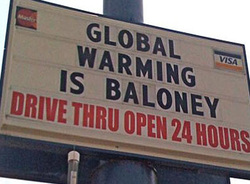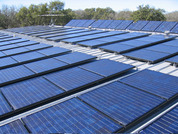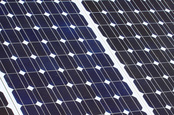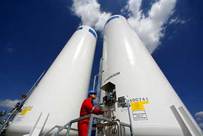 By their nature, scientific projections are subject to uncertainties and debate. For those who believe the catastrophic climate change projections are or might be wrong, I ask the following questions:
Should we continue sending billions of dollars out of the country to buy oil from people and governments that hate us?
Should we continue to burn coal, petroleum, and other fossil fuels that emit small particles triggering heart attacks and causing other coronary and respiratory ailments at a cost of at least hundreds of millions of dollars in increased medical expenses?
Should we allow Germany, China, India and a few other countries to become the global leaders in new clean energy technologies, creating highly-skilled and high-paying jobs (not to mention the highest employment rates in their respective histories), while we moan about the loss of good paying jobs in America?
Should we continue to subsidize oil companies that earn record profits and then keep as much of their profits as possible offshore to avoid paying taxes in the US?
Should we continue to waste energy in inefficient homes and vehicles like cartoon characters literally burning dollars?
Should we build renewable energy power plants that will have zero fuel costs in the future? Or should we build traditional power plants that will continue to consume ever-more-expensive fuels? Which option will help us build a competitive economy?
And lest you think I'm avoiding the climate change part of the equation........
What if you're right?
What if the climate change proponents turn out to be Chicken Littles? What terrible things happen if we reduce our dependence on coal and oil, reduce waste in our consumption of energy, reduce our emissions of pollutants, become energy self-sufficient, create new jobs in new technologies, eliminate hundreds of billions of dollars in government spending on wars to protect access to oil fields, and become the world leader in renewable technologies that have zero ongoing fuel costs?
What if we do all that and then find out that climate change is not happening? What will we have lost?
Now ask yourselves, what if you're wrong?
What if the majority of climate scientists are correct? What if our children, grandchildren, or great-grandchildren have to live (and die) with the effects of climate change feedback loops 50, 100, or 150 years from now. What will you have accomplished with your selfish insistence today that you and you alone know with certainty what the future holds?
Those of us who believe that the RISKS of climate change are real are not suggesting that we have all the answers or that the projections are perfect. But we are confident that diversifying our energy sources will be good for the economy, good for job creation, good for our quality of life, and yes, good for the environment that we and hopefully many long lines of descendants will live in.
John Howley
Orlando, Florida
 The US Postal Service (USPS) has avoided $400 million in energy costs since fiscal year 2007 by focusing on energy efficient designs and software to manage the efficiency of its operations and energy consumption. USPS operations today are using approximately 30% less energy than in 2003. One of the most visible efforts is the 2.5-acre "green roof" above the USPS Morgan Mail Processing and Distribution Facility in New York City -- the city's largest green roof. In its first year alone, the facility was able to avoid more than $1 million in energy costs and reduce energy consumption by 40 percent. The green roof also reduced pollution runoff between 35 to 75 percent, depending on the season. Plus, the green roof will last approximately 50 years. Other significant energy savings measures implemented by USPS include energy audits, employee education, and sophisticated energy management and controls systems. The USPS also adopted a number of different software systems to increase the efficiency of its basic business -- sorting and delivering the mail to every address in the US. The IT solutions include software to optimize mail sorting programs and reduce the number of partially filled mail trays; and an "Intelligent Mail" barcode system to improve mail routing and tracking. The USPS has also brought its suppliers into the process. By 2015, every supplier with a contract worth more than $500,000 will be required to submit sustainability data. The USPS also produces its own annual sustainability report detailing its energy consumption, carbon footprint and greenhouse gas (GHG) emissions, conservation efforts, goals, and progress towards those goals. John HowleyWoodbridge, New Jersey
 Solar panels in the northern hemisphere should generally tilt south to maximize the generation of energy. But in the US, solar panels are installed with a slightly westward tilt. Why? Because the power of physics is trumped by the power of economics and finance.
Electricity rates in the US are generally higher in the afternoon. A kilowatt-hour (kwh) generated by your solar power system in the afternoon is worth more than a kwh generated in the morning. So it makes sense to generate more kwhs of solar power in the afternoon, even if that means your solar power system loses more kwhs of potential generating capacity in the morning.
Yes, we are being intentionally inefficient when capturing the sun's power because that inefficiency generates more cash.
This is yet one more reason why the future of green and sustainable energy depends as much on economics, finance and government regulation as it does on the development of new technologies. Indeed, as we will discuss in future blog posts, government regulations that effect the economics and financing of green and sustainable energy will determine whether or not inventors can attract the investments necessary to develop new technologies.
John Howley
Woodbridge, New Jersey
 Private equity firm Kohlberg Kravis Roberts (KKR) joined with the world's largest reinsurance company, Munich Re, to purchase a 49% interest in solar power plants owned and operated by T-Solar Global SA. T-Solar is the largest owner-operator of solar power plants in Spain and Italy, with a generating capacity of 168 megawatts.
T-Solar will use the cash infusion to triple its solar capacity to 500 megawatts by 2014. As part of the deal, KKR and Munich Re have options to invest in future plants.
Also this week, France's AXA Private Equity announced that it has acquired 15 wind farms around Paris with a combined capacity of 163MW. The acquisition makes AXA Private Equity the fourth largest wind power operator in France.
These are just the most recent renewable energy deals by large private equity firms and insurance companies. In December, a Munich Re affiliate invested in 40 German wind turbines with a generating capacity 73 megawatts. In June, KKR formed a partnership with Sorgenia SpA to develop wind power projects in France. And Munich Re announced plans this week to invest another 2.5 billion euros in renewable energy assets “relatively quickly.”
Why are large private equity firms and insurance companies investing in renewable energy when countries such as Spain and the Czech Republic have cut subsidies for wind and solar projects? The fundamentals are very attractive. Costs for wind and solar keep coming down (and they have no ongoing fuel costs), while prices for fossil fuels for traditional power plants have remained high throughout the Great Recession and will only go higher once economic growth returns. The smart money knows that it can be very profitable to be in a business where your costs keep getting lower and your only competition will continue to get more expensive.
John Howley
Woodbridge, New Jersey
 American Electric Power (AEP) is shelving plans for the largest Carbon Capture and Sequestration (CCS) project in the country due to the uncertain status of U.S. climate policy and the continued weak economy. "We are placing the project on hold until economic and policy conditions create a viable path forward," said Michael G. Morris, AEP's Chairman and Chief Executive Officer.
A significant part of the problem is the federal government's failure to require all power generators to lower their carbon emissions. With such a requirement, AEP and its partners would have a competitive advantage by developing cutting edge technology to reduce carbon emissions from existing coal-fired power plants. That competitive advantage would inspire others to invest in competing CCS and related technologies to lower their carbon emissions as well.
Without such a requirement, however, innovation stops. The industry stays at the lowest common denominator -- i.e., the highest allowable carbon emissions -- to avoid the time and expense of creating new solutions to carbon and other forms of pollution.
Another significant part of the problem is a century-old, state-by-state regulatory structure that does not allow utilities to recover the costs of technologies that reduce carbon emissions. As AEP's Chairman and CEO explains, "We are clearly in a classic 'which comes first?' situation. The commercialization of this technology is vital if owners of coal-fueled generation are to comply with potential future climate regulations without prematurely retiring efficient, cost-effective generating capacity. But as a regulated utility, it is impossible to gain regulatory approval to recover our share of the costs for validating and deploying the technology without federal requirements to reduce greenhouse gas emissions already in place. The uncertainty also makes it difficult to attract partners to help fund the industry's share."
Until this announcement, AEP was working with the U.S. Department of Energy (DOE) and others to install a commercial-scale CCS system at AEP's Mountaineer coal-fueled power plant in West Virginia. The system would have captured at least 90 percent of the carbon dioxide (CO2) from 235 megawatts of the plant's 1,300 megawatts of capacity. The captured CO2, approximately 1.5 million metric tons per year, would have been treated and compressed, then injected into geologic formations for permanent storage approximately 1.5 miles below the surface.
Plans were for the project to be completed in four phases, with the system to begin commercial operation in 2015. AEP has informed the DOE that it will complete the first phase of the project (front-end engineering and design, development of an environmental impact statement and development of a detailed Phase II and Phase III schedule) but will not move to the second phase.
Whether or not CCS is the right technology to reduce carbon emissions is not the point. The point is this: If the government requires utilities to reduce their carbon emissions, it will set off competition between the utilities to come up with the most efficient and cost-effective technology to reduce the emissions. That competition will lead to investments, job creation, and innovation that will make our country a technological leader in carbon reduction technologies. As Germany is demonstrating right now with the healthiest economy and the highest employment rate in modern history, becoming a technology innovator is the way to compete against lower-wage, developing countries.
On the other hand, if the government requires nothing, then the utilities will do nothing. No investment in new technologies. No new jobs for scientists, engineers, and other high paying professionals. No technological advantage over lower-wage, developing countries.
John Howley
Woodbridge, New Jersey
Does your organization appreciate and understand the value of integrating sustainability in its strategic plan, as well as the very tangible benefits it creates for the organization and its community? Today sustainability is not just a catchphrase. For many businesses, colleges and universities, and communities, sustainability is an integral part of their strategic plans and ongoing operations. By aligning sustainable strategies and initiatives with their core values and mission, these organizations are able to: - create competitive advantages, revenue growth, and long-term value
- improve operational performance, increase efficiencies, and reduce costs
- reduce greenhouse gas (GHG) emissions and other environmental impacts
- manage regulatory and market risks
- enhance the organization's reputation
Integrating sustainability into your organization's strategic plan and ongoing operations requires a four-step process: Sustainability Assessment, Strategic Planning, Implementation, and Performance Evaluation and Reporting. Sustainability AssessmentThe purpose of a sustainability assessment is to help your organization identify risks, challenges, and opportunities. This involves an analysis of existing initiatives, resource allocations and staff capabilities in the context of industry-specific best practices. It also includes the development of reliable baselines of energy and water consumption, waste generation, greenhouse gas (GHG) emissions, and related costs. From there, your organization can begin to consider existing and alternative sources of energy, water, and other critical resources. You can identify and apply appropriate benchmarks. And you can develop measurement and verification plans to evaluate progress over time. Strategic PlanningSustainable strategic planning is a matter of making sustainable choices that will promote and enhance your organization's core values, mission, and aspirations. This requires looking at best practices within your specific industry, proven and emerging technologies, and government policies and incentives. To be effective, your organization must incorporate this knowledge and information into its strategic plan, establish realistic targets and timetables, and calculate the initial and ongoing resources and staffing that will be required to meet those targets and timetables. ImplementationStrategic plans, energy audits, and other forms of assessments and goal setting are too often wasted because of inadequate implementation or execution. Developing an effective strategic plan will help in this regard, but the targets and timetables established in the plan must be supported with an action agenda that specifies who will be responsible for executing the plan and how (both in terms of staffing and funding) they will meet expectations. Outside facilitators can often assist an organization at the implementation stage by providing both expertise and objective, focused attention on achieving results. Performance Evaluation and ReportingYou cannot manage what you do not measure. Accordingly, your organization should have well-designed performance evaluation tools to measure and verify progress towards targets and objectives. The tools can include report cards and dashboards summarizing progress and gaps to promote accountability and continuous improvement. These tools also ensure effective governance and oversight. Your organization should also consider the recognition and competitive advantages that may result from submitting data to the Carbon Disclosure Project (CDP), the Global Reporting Initiative (GRI), the Walmart Sustainability Survey, and industry specific indexes and reports. After all, if you've already done the work and achieved the results, you might as well get credit for it. John HowleyWoodbridge, New Jersey
A father and son team has set off from New York City in a human-electric hybrid vehicle that will take them across the country using the energy equivalent of just two gallons of gas to travel 4,000 miles. Pierce Hoover, an inventor and journalist, came up with the idea to teach his son the value of turning off a single 100 watt light bulb. That is the amount of energy they will use each day to travel across the United States.
Hoover and his 13 year-old son have embarked on this trip to publicize the energy we can all save by turning off unneeded lights and appliances. In addition to reducing our electric bills, we can also help the environment.
The idea for the trip came about when Hoover was trying to figure out how to persuade his son to stop leaving lights on around the house. He brought his son to a local gym, where exercise bikes measure energy output in watts. When his son tried to pedal fast enough to generate enough energy to power s single 100-watt bulb, he realized how much energy was needed to power even simple household devices.
This led to a bigger idea. One that would demonstrate how much could be done with the energy saved by turning off just one light. They set a goal of crossing the country on the power of one 100 watt light bulb per day. Then they worked with a team of engineers to design and build a human-electric hybrid vehicle with a 100-watt motor fueled by battery power and the kinetic energy of pedaling.
John Howley
Woodbridge, New Jersey
|





 RSS Feed
RSS Feed